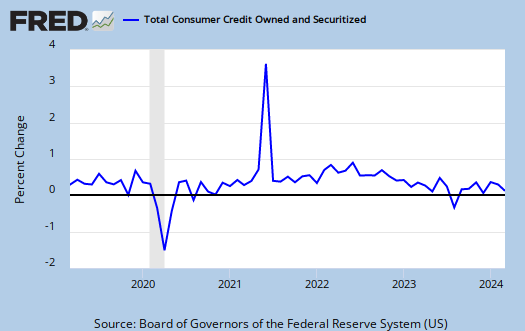The Federal Reserve has released consumer credit for February 2010. This metric does not include consumer debt securitized with residential property (does not include your mortgage).

Consumer credit decreased at an annual rate of 5-1/2 percent in February 2010. Revolving credit decreased at an annual rate of 13 percent, and nonrevolving credit decreased at an annual rate of 1-1/2 percent.
Yes, I know the report text says 5.5%, but the data columns contained within are 5.6%, so assume someone made a data boo-boo in this release.
CBS MarketWatch answers the question on how much of this decline was charge offs or people actually paid down their debt. Charge offs means loan holders just wrote the debt off their books as a loss, a debt they will never collect on.
In 2009, charge-offs on consumer loans by banks increased by $18 billion to $52.2 billion, while outstanding debts fell by $112 billion to $2.45 trillion.
As of the fourth quarter of 2009, households were paying 12.6% of their disposable income to service their debts, down from 13.9% at the peak of the credit bubble in 2007. That's the lowest debt-to-income ratio since 2000. In the early 1990s, households were paying less than 11% of disposable incomes to service their debts.
In a separate report Wednesday, the American Bankers Association said delinquencies on consumer debts owed to banks declined once again in the fourth quarter. The aggregate delinquency rate for eight different types of loans fell to 3.19% in the fourth quarter from 3.23% in the third quarter. For bank credit cards, the delinquency rate fell from 4.77 % to 4.39 %.
Business Insider amplifies the increase in government consumer lending with this graph:

To put the increase in government lending in perspective, I give this alternative graph of all consumer lending institutions and their holdings:

The key is Sallie Mae (student loans) is included in the government statistics as well as those evil securitized pools (see foot notes 5,6).
That said, the 5.6% consumer credit February decline implies our tapped out consumer (always ignored as a worker, a producer), either by force or by choice, is deleveraging. So of course investors are crying because they won't get another consumer drowning in debt fueled recovery. Boohoo! If only investors had similar reactions to layoff and unemployment reports.

Recent comments